Anatomical Concepts of Distraction Osteogenesis: An Orthopaedic Case in Western Kenya
Adero Walter1, Marera Domnic1*
1Department of Human Anatomy, School of Medicine, Maseno University, Private bag-40105 Maseno- Kenya
*Corresponding Author: Domnic Marera, Department of Human Anatomy, School of Medicine, Maseno University, Private bag-40105 Maseno- Kenya
Received: 18 May 2021; Accepted: 24 May 2021; Published: 28 May 2021
Article Information
Citation:
Adero Walter, Marera Domnic. Anatomical Concepts of Distraction Osteogenesis: An Orthopaedic Case in Western Kenya. Journal of Orthopaedics and Sports Medicine 3 (2021): 075-081.
View / Download Pdf Share at FacebookAbstract
Various pathologies that lead to bone gaps of are difficult to manage and each presentation may require an individualized protocol of management. In the present case, the compound wedge fracture was initially sub-optimally managed leading to more complications, non-union, large collection of sequestrum and sepsis. This unique case required a complex management and salvage of the limb without damaging vital relations such as the nerves, muscles and blood vessels. After thorough assessment, a distraction osteogenesis procedure was recommended to restore the limb functions.
Keywords
Osteogenesis; Remodeling; Bone
Orthopaedic articles Orthopaedic Research articles Orthopaedic review articles Orthopaedic PubMed articles Orthopaedic PubMed Central articles Orthopaedic 2023 articles Orthopaedic 2024 articles Orthopaedic Scopus articles Orthopaedic impact factor journals Orthopaedic Scopus journals Orthopaedic PubMed journals Orthopaedic medical journals Orthopaedic free journals Orthopaedic best journals Orthopaedic top journals Orthopaedic free medical journals Orthopaedic famous journals Orthopaedic Google Scholar indexed journals Human anatomy articles Human anatomy Research articles Human anatomy review articles Human anatomy PubMed articles Human anatomy PubMed Central articles Human anatomy 2023 articles Human anatomy 2024 articles Human anatomy Scopus articles Human anatomy impact factor journals Human anatomy Scopus journals Human anatomy PubMed journals Human anatomy medical journals Human anatomy free journals Human anatomy best journals Human anatomy top journals Human anatomy free medical journals Human anatomy famous journals Human anatomy Google Scholar indexed journals Distruction osteogenesis articles Distruction osteogenesis Research articles Distruction osteogenesis review articles Distruction osteogenesis PubMed articles Distruction osteogenesis PubMed Central articles Distruction osteogenesis 2023 articles Distruction osteogenesis 2024 articles Distruction osteogenesis Scopus articles Distruction osteogenesis impact factor journals Distruction osteogenesis Scopus journals Distruction osteogenesis PubMed journals Distruction osteogenesis medical journals Distruction osteogenesis free journals Distruction osteogenesis best journals Distruction osteogenesis top journals Distruction osteogenesis free medical journals Distruction osteogenesis famous journals Distruction osteogenesis Google Scholar indexed journals Bone defects articles Bone defects Research articles Bone defects review articles Bone defects PubMed articles Bone defects PubMed Central articles Bone defects 2023 articles Bone defects 2024 articles Bone defects Scopus articles Bone defects impact factor journals Bone defects Scopus journals Bone defects PubMed journals Bone defects medical journals Bone defects free journals Bone defects best journals Bone defects top journals Bone defects free medical journals Bone defects famous journals Bone defects Google Scholar indexed journals Maxillofacial articles Maxillofacial Research articles Maxillofacial review articles Maxillofacial PubMed articles Maxillofacial PubMed Central articles Maxillofacial 2023 articles Maxillofacial 2024 articles Maxillofacial Scopus articles Maxillofacial impact factor journals Maxillofacial Scopus journals Maxillofacial PubMed journals Maxillofacial medical journals Maxillofacial free journals Maxillofacial best journals Maxillofacial top journals Maxillofacial free medical journals Maxillofacial famous journals Maxillofacial Google Scholar indexed journals Osteogenesis articles Osteogenesis Research articles Osteogenesis review articles Osteogenesis PubMed articles Osteogenesis PubMed Central articles Osteogenesis 2023 articles Osteogenesis 2024 articles Osteogenesis Scopus articles Osteogenesis impact factor journals Osteogenesis Scopus journals Osteogenesis PubMed journals Osteogenesis medical journals Osteogenesis free journals Osteogenesis best journals Osteogenesis top journals Osteogenesis free medical journals Osteogenesis famous journals Osteogenesis Google Scholar indexed journals Limb salvage articles Limb salvage Research articles Limb salvage review articles Limb salvage PubMed articles Limb salvage PubMed Central articles Limb salvage 2023 articles Limb salvage 2024 articles Limb salvage Scopus articles Limb salvage impact factor journals Limb salvage Scopus journals Limb salvage PubMed journals Limb salvage medical journals Limb salvage free journals Limb salvage best journals Limb salvage top journals Limb salvage free medical journals Limb salvage famous journals Limb salvage Google Scholar indexed journals Craniofacial surgeries articles Craniofacial surgeries Research articles Craniofacial surgeries review articles Craniofacial surgeries PubMed articles Craniofacial surgeries PubMed Central articles Craniofacial surgeries 2023 articles Craniofacial surgeries 2024 articles Craniofacial surgeries Scopus articles Craniofacial surgeries impact factor journals Craniofacial surgeries Scopus journals Craniofacial surgeries PubMed journals Craniofacial surgeries medical journals Craniofacial surgeries free journals Craniofacial surgeries best journals Craniofacial surgeries top journals Craniofacial surgeries free medical journals Craniofacial surgeries famous journals Craniofacial surgeries Google Scholar indexed journals Skeletal abnormalities articles Skeletal abnormalities Research articles Skeletal abnormalities review articles Skeletal abnormalities PubMed articles Skeletal abnormalities PubMed Central articles Skeletal abnormalities 2023 articles Skeletal abnormalities 2024 articles Skeletal abnormalities Scopus articles Skeletal abnormalities impact factor journals Skeletal abnormalities Scopus journals Skeletal abnormalities PubMed journals Skeletal abnormalities medical journals Skeletal abnormalities free journals Skeletal abnormalities best journals Skeletal abnormalities top journals Skeletal abnormalities free medical journals Skeletal abnormalities famous journals Skeletal abnormalities Google Scholar indexed journals Vertebral column articles Vertebral column Research articles Vertebral column review articles Vertebral column PubMed articles Vertebral column PubMed Central articles Vertebral column 2023 articles Vertebral column 2024 articles Vertebral column Scopus articles Vertebral column impact factor journals Vertebral column Scopus journals Vertebral column PubMed journals Vertebral column medical journals Vertebral column free journals Vertebral column best journals Vertebral column top journals Vertebral column free medical journals Vertebral column famous journals Vertebral column Google Scholar indexed journals Bone fractures articles Bone fractures Research articles Bone fractures review articles Bone fractures PubMed articles Bone fractures PubMed Central articles Bone fractures 2023 articles Bone fractures 2024 articles Bone fractures Scopus articles Bone fractures impact factor journals Bone fractures Scopus journals Bone fractures PubMed journals Bone fractures medical journals Bone fractures free journals Bone fractures best journals Bone fractures top journals Bone fractures free medical journals Bone fractures famous journals Bone fractures Google Scholar indexed journals Femur articles Femur Research articles Femur review articles Femur PubMed articles Femur PubMed Central articles Femur 2023 articles Femur 2024 articles Femur Scopus articles Femur impact factor journals Femur Scopus journals Femur PubMed journals Femur medical journals Femur free journals Femur best journals Femur top journals Femur free medical journals Femur famous journals Femur Google Scholar indexed journals Soft-tissues articles Soft-tissues Research articles Soft-tissues review articles Soft-tissues PubMed articles Soft-tissues PubMed Central articles Soft-tissues 2023 articles Soft-tissues 2024 articles Soft-tissues Scopus articles Soft-tissues impact factor journals Soft-tissues Scopus journals Soft-tissues PubMed journals Soft-tissues medical journals Soft-tissues free journals Soft-tissues best journals Soft-tissues top journals Soft-tissues free medical journals Soft-tissues famous journals Soft-tissues Google Scholar indexed journals Chondrocytes articles Chondrocytes Research articles Chondrocytes review articles Chondrocytes PubMed articles Chondrocytes PubMed Central articles Chondrocytes 2023 articles Chondrocytes 2024 articles Chondrocytes Scopus articles Chondrocytes impact factor journals Chondrocytes Scopus journals Chondrocytes PubMed journals Chondrocytes medical journals Chondrocytes free journals Chondrocytes best journals Chondrocytes top journals Chondrocytes free medical journals Chondrocytes famous journals Chondrocytes Google Scholar indexed journals Fibro-cartilaginous articles Fibro-cartilaginous Research articles Fibro-cartilaginous review articles Fibro-cartilaginous PubMed articles Fibro-cartilaginous PubMed Central articles Fibro-cartilaginous 2023 articles Fibro-cartilaginous 2024 articles Fibro-cartilaginous Scopus articles Fibro-cartilaginous impact factor journals Fibro-cartilaginous Scopus journals Fibro-cartilaginous PubMed journals Fibro-cartilaginous medical journals Fibro-cartilaginous free journals Fibro-cartilaginous best journals Fibro-cartilaginous top journals Fibro-cartilaginous free medical journals Fibro-cartilaginous famous journals Fibro-cartilaginous Google Scholar indexed journals
Article Details
1. Introduction
Distruction osteogenesis is a novel technique utilizing intramembranous ossification of bone to equalize discrepant limb lengths. It involves a low energy corticotomy and slow deliberate distraction of callus to fill large bone defects. In addition to equalizing limb lengths, destraction osteogenesis has successfully been used in maxillofacial cosmesis and orthopedic limb salvage [1]. The concept of intentional destruction followed by controlled healing process of bones can be traced back as early as 1905 [2]. Its main intention was to ensure healing while increasing the length of a bone whose original length was shortened by trauma or pathology. However; this concept fully resurged in orthopedics in early 1950s [3].
Initially, Destruction osteogenesis was only used in long bones (endochondral ossification), however, in early 1990s, McCarthy [4] successfully applied the procedure on short and irregular bones (intramembranous ossification). This led to its current applications in complex craniofacial surgeries and other cosmetic procedures. In addition, with the current technologies, distructive osteogenesis can successfully be applied in correcting congenital skeletal abnormalities [5].
2. Historical Background
Hippocrates, the father of modern medicine, documented a multidisciplinary treatise devoted to orthopedics. He described detailed gross anatomy of the vertebral column and pioneered the use of the ‘Hippocratic ladder’ to treat these injuries. There’s evidence supporting traditional bone setting in ancient Africa and China. There is archeological evidence of healed, well–aligned long bone fractures [6]. Guy de Chauliac, a prominent French surgeon, pioneered the use of isotonic traction to treat fractures of the femur. He utilized a system of pulleys, cords and suspended weights that ensured traction in line with the long axis of the femur [7]. Gavril Ilizarov, a prominent soviet orthopaedic surgeon and researcher is the most widely quoted author and considered the father of distraction osteogenesis. He chanced upon this discovery when a patient he was managing distracted a fracture instead of compressing [8].
2.1 Case
A 44-year-old male, FO, was a passenger on a motorbike that got involved in an accident on 28.09.2018. An oncoming motor vehicle lost control and rammed them on a busy inter-city highway.
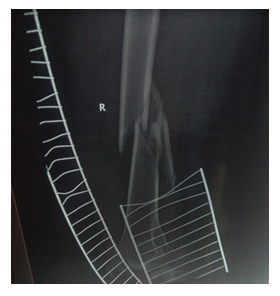
Figure 1: Initial trauma radiograph showing a comminuted, wedge fracture of the right femoral shaft.
He sustained an isolated comminuted, wedge fracture of his right femoral shaft. He underwent sub-optimal treatment of his injury with a large fragment plate and screws that did not heal adequately after a follow-up period of four months (Figure 1). He developed an infected non-union with a huge sequestrum developing underneath the plate. A decision was made to undertake multi-staged surgery to salvage his limb. The first surgery involved removing the infected implants and sequestrum. This subsequently left a 25 cm gap that was filled with antibiotic-impregnated bone cement (Figure 2).
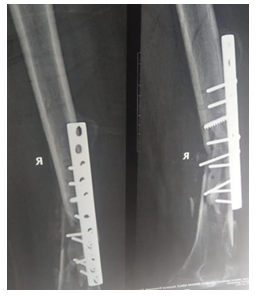
Figure 2: Sub-optimal treatment of fracture with a plate. Later developed into an infected non-union with a large sequestrum underneath the plate.
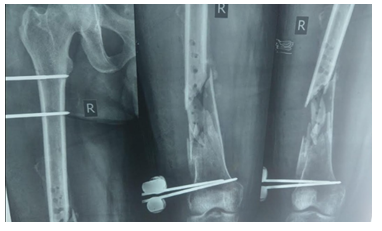
Figure 3: Plate removed and fracture stabilized with an external fixator.
The next stage was carried out after 6 weeks. A complex procedure where an intramedullary nail was placed in such a manner that length was maintained (Figure 3). A uniplanar transport frame was also applied in the same sitting and proximal corticotomy done. Bone transport of the intervening segment of bone commenced after one week of recuperating and education. Transport was done at the rate of 1mm per day over a period of 3 months. Traction was stopped when desired length was achieved.
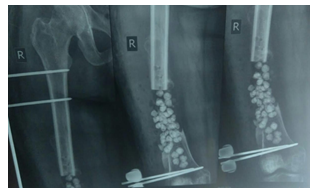
Figure 4: Sequestrum removed and 25cm gap filled with antibiotic beads.
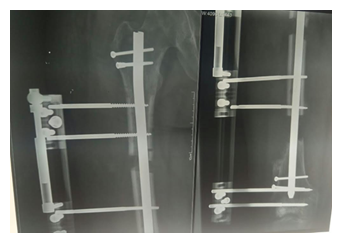
Figure 5: Proximal osteotomy done, manual transport frame placed and bone transport commenced.
He was then followed up every two weeks for dressing changes and monitoring of pin-sites and soft-tissues. Serial radiographs were also done to monitor progress (Figure 5).
3. Anatomic Principles
Osteogenic distraction progress is monitored radiographically and clinically. Clinical monitoring involves measuring the length on the externally placed transport frame. Radiologic monitoring utilizes the amount of callus seen on plain radiographs. Radiographically two zones form, two sclerotic zones peripherally with an intervening middle radiolucent zone that eventually calcifies to form solid bone. Histologically this radiolucent zone contains islands of chondrocytes that eventually ossify via endochondral ossification to form solid tubular bone. Normal long bone fracture healing processes in adults takes 8-12 weeks to fully consolidate (Figure 4).
The first stage of normal fracture healing occurs when the blood vessels surrounding bone and soft tissues are disrupted thus forming a hematoma around the fracture site. This hematoma acts as the initial framework where inflammation and callus formation will take place. This stage takes approximately one week. The next stage is inflammatory – during this stage the inflammatory cascade is activated, cells and cytokines congregate at the fracture site to initiate the healing process. Neutrophils, macrophages and various growth factors have been shown to play a crucial role during this inflammatory phase. The inflammatory mediators, white blood cells and young chondroblasts invade the hematoma site leading to cardinal signs of inflammation over one week.
The third stage, fibro-cartilaginous stage begins when fibroblasts and osteoblastic cells invade the hematoma to begin forming callus. Callus is a soft, demineralized osteon. The osteoblasts undergo active mitotic division at this stage and matures to form osteocytes thus converting the soft callus into hard callus. At this stage, hard callus formation is intentionally disrupted (thus the term distraction osteogenesis) and the soft callus is expanded sequentially until the desired length is achieved.
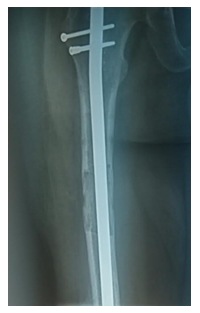
Figure 6: Bone transport complete with solid bone remodeling.
Once the original length is achieved, the normal histogenic regenerative process of bone mass, shape and size is attained through bone remodeling and calcification of the hard callus. Bone remodels according to the amount of mechanical stress it is exposed to (Wolff’s law) [9]. These stages overlap and this entire process begins when the fracture occurs and lasts till one year after the initial injury.
Multiple factors contribute to the success or failure of distraction. Rate of distraction, type of fixation and timing are important however preserving the periosteum has been shown to play a critical role. Biomechanical studies of the callus formed following distraction for 8 weeks has been shown to be robust enough to allow full weight bearing and removal of the implants.
Common complications associated with this method include pin-site infections, restricted joint motion, angular deviations and fractures after removal of the frames. The traction force on bone also creates tension on the surrounding soft tissues. These slow adaptive changes are known as distraction histogenesis. There is paucity of documented soft-tissue complications. The slow, stretch of overlying skin, muscles and nerves appears tolerable to most patients [10].
Osteogenic distraction is also a multi-stage process that closely mirrors fracture healing. The low energy osteotomy that initiates the process. This triggers the fracture hematoma. This is followed by a period of latency – mirrors inflammation. The distraction process – fibro-cartilaginous and callus formation. The final stages – consolidation and remodeling [10].
4. Conclusions
Distraction osteogenesis was successfully applied in this case. It took a total of 92 days under close supervision to fill a bone defect of 25 cm. The new bone formed was structurally sound enough to allow both kinetic and static functions of the limb. Post-management radiographs showed full osteon formation and related surrounding tissue healed normally.
Funding
This research received no specific grant from any funding agency in the public, commercial, or not-for-profit sectors.
Declaration of Conflicting Interests
The authors report no conflict of interest
References
- Cope JB, Samchukov ML, Cherkashin AMJAjoo, et al. Mandibular distraction osteogenesis: a historic perspective and future directions 115 (1999): 448-460.
- Selvaraj NV. Ilizarovs Limb lengthening procedure in a complicated post traumatic shortened limb-A rare case report. University Journal of Surgery and Surgical Specialities 5 (2019).
- Bonnard C, Favard L, Sollogoub I, et al. Limb lengthening in children using the Ilizarov method (1993): 83-88.
- Karp NS, McCarthy JG, Schreiber JS, et al. Membranous bone lengthening: a serial histological study 29 (1992): 2-7.
- Maffulli N, Lombari C, Matarazzo L, et al. A review of 240 patients undergoing distraction osteogenesis for congenital post-traumatic or postinfective lower limb length discrepancy 182 (1996): 394-402.
- Marketos SG, Skiadas PJS. Hippocrates: The father of spine surgery 24 (1999): 1381.
- Hernigou P, Dubory A, Roubineau FJIo. History of traction for treatment of lower limb fractures 40 (2016): 2635-2641.
- Goldstein RY, Jordan CJ, McLaurin TM, et al. The evolution of the Ilizarov technique: part 2: the principles of distraction osteosynthesis 71 (2013): 96.
- Bertram JE, Swartz SMJBR. The law of bone transformation: a case of crying Wolff? 66 (1991): 245-273.
- Tetsworth K, Paley DJCOiO. Basic science of distraction histogenesis 6 (1995): 61-67.


 Impact Factor: * 5.3
Impact Factor: * 5.3 Acceptance Rate: 73.64%
Acceptance Rate: 73.64%  Time to first decision: 10.4 days
Time to first decision: 10.4 days  Time from article received to acceptance: 2-3 weeks
Time from article received to acceptance: 2-3 weeks 